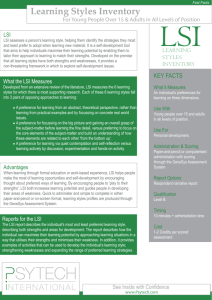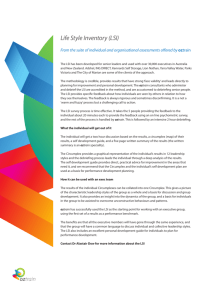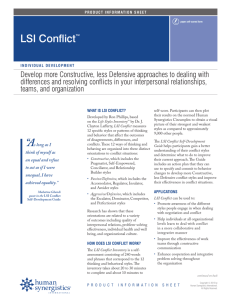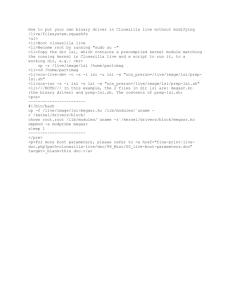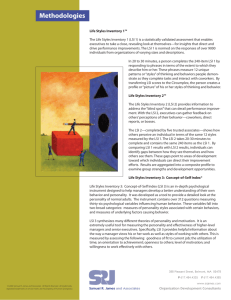Trait Theories of Leadership
advertisement
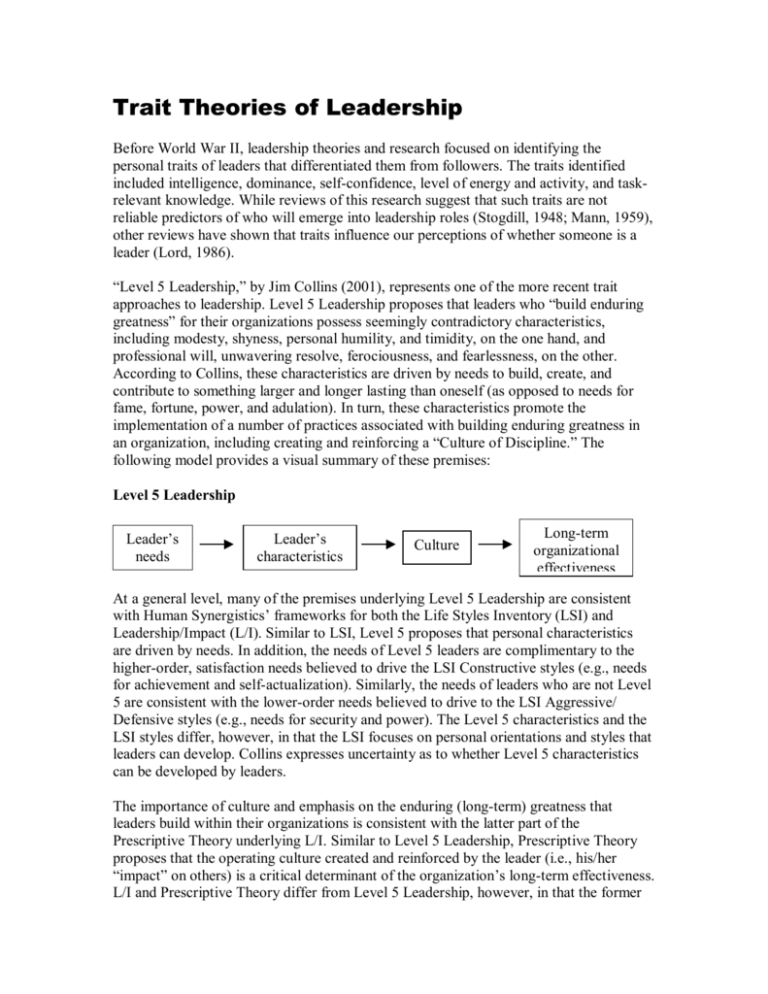
Trait Theories of Leadership Before World War II, leadership theories and research focused on identifying the personal traits of leaders that differentiated them from followers. The traits identified included intelligence, dominance, self-confidence, level of energy and activity, and taskrelevant knowledge. While reviews of this research suggest that such traits are not reliable predictors of who will emerge into leadership roles (Stogdill, 1948; Mann, 1959), other reviews have shown that traits influence our perceptions of whether someone is a leader (Lord, 1986). “Level 5 Leadership,” by Jim Collins (2001), represents one of the more recent trait approaches to leadership. Level 5 Leadership proposes that leaders who “build enduring greatness” for their organizations possess seemingly contradictory characteristics, including modesty, shyness, personal humility, and timidity, on the one hand, and professional will, unwavering resolve, ferociousness, and fearlessness, on the other. According to Collins, these characteristics are driven by needs to build, create, and contribute to something larger and longer lasting than oneself (as opposed to needs for fame, fortune, power, and adulation). In turn, these characteristics promote the implementation of a number of practices associated with building enduring greatness in an organization, including creating and reinforcing a “Culture of Discipline.” The following model provides a visual summary of these premises: Level 5 Leadership Leader’s needs Leader’s characteristics Culture Long-term organizational effectiveness At a general level, many of the premises underlying Level 5 Leadership are consistent with Human Synergistics’ frameworks for both the Life Styles Inventory (LSI) and Leadership/Impact (L/I). Similar to LSI, Level 5 proposes that personal characteristics are driven by needs. In addition, the needs of Level 5 leaders are complimentary to the higher-order, satisfaction needs believed to drive the LSI Constructive styles (e.g., needs for achievement and self-actualization). Similarly, the needs of leaders who are not Level 5 are consistent with the lower-order needs believed to drive to the LSI Aggressive/ Defensive styles (e.g., needs for security and power). The Level 5 characteristics and the LSI styles differ, however, in that the LSI focuses on personal orientations and styles that leaders can develop. Collins expresses uncertainty as to whether Level 5 characteristics can be developed by leaders. The importance of culture and emphasis on the enduring (long-term) greatness that leaders build within their organizations is consistent with the latter part of the Prescriptive Theory underlying L/I. Similar to Level 5 Leadership, Prescriptive Theory proposes that the operating culture created and reinforced by the leader (i.e., his/her “impact” on others) is a critical determinant of the organization’s long-term effectiveness. L/I and Prescriptive Theory differ from Level 5 Leadership, however, in that the former attributes the culture to the strategies and actions taken by the leader; Level 5 Leadership attributes the culture to the leader’s personal characteristics. While this difference does not necessarily represent a contradiction between Prescriptive Theory and Level 5 Leadership, it does suggest a different focus in terms of what organizations should do to obtain great leaders. Level 5 Leadership suggests that great leaders have to be hired; Prescriptive Leadership suggests that great leaders can be developed. Level 5 Leadership Theory can be useful in helping leaders to understand the differences between the LSI Constructive and Aggressive/Defensive styles, as well as in promoting their understanding of the importance of culture and the goal of great leadership. However, some of the specific terms used in Level 5 Leadership could be viewed as confusing in the context of the LSI and L/I. For example, “modest” is an aspect of the Dependent style, while “Culture of Discipline” could be misinterpreted as meaning one that is Power and Dependent oriented. While Collins was not implying that either dependence or power orientations are desirable (and, in fact, says the opposite), people could easily assume otherwise, particularly if they have not read Collins’ work carefully. Collins, J. (January 2001). Level 5 Leadership: The Triumph of Humility and Fierce Resolve. Harvard Business Review, pp. 66-76. Lord, R. G., De Vader, C. L., and Alliger, G. M. (August 1986). A Meta-Analysis of the Relation between Personality Traits and Leadership Perceptions: An Application of Validity Generalization Procedures. Journal of Applied Psychology, 407. Mann, R. D. (July 1959). A Review of the Relationship between Personality and Performance in Small Groups. Psychological Bulletin, pp. 241-270. Stogdill, R. M. (1948). Personal Factors Associated with Leadership: A Survey of the Literature. Journal of Applied Psychology, pp. 35-71.
